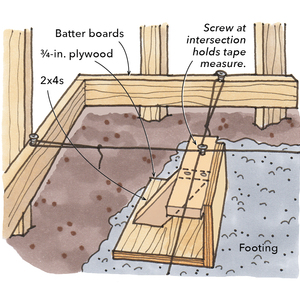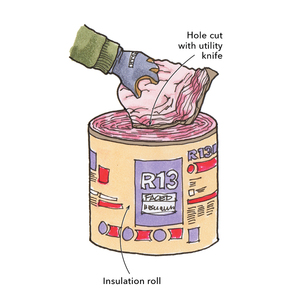Hello, <!—-><!—-> <!—->
<!—-> <!—->
I’m starting the excavation for a building that will be 400 feet from the current electrical service. Are their any options for running temporary electrical this distance, my 12ga extension cord isn’t going to cut it. Any ideas? Double 12ga cords, etc.. 15AMPS will be the max draw… I’m not really wanting to buy a generator.<!—-> <!—->
<!—-> <!—->
How about running an air hose for this distance? Will I have any issues running the framing nailer… <!—-><!—->
<!—-> <!—->
Thanks, <!—-><!—->
<!—-> <!—->
Eric



















Replies
I made a 10 guage extension cord for this exact purpose and it is 150 feet long, and runs air compressors etc without voltage drop.
I dunno about 400 feet though. I'm sure 8 or 10 would work fine. Expect to pay about a buck a foot.
Regards,
Scooter
"I may be drunk, but you're crazy, and I'll be sober tomorrow." WC Fields, "Its a Gift" 1934
One approach is to run the air hose for some or all of the distance, and to put an aux air tank at the tool end of the run. Especially when used for nailers, the air is used in bursts, and the aux tank will have the capacity to ride out several near-simultaneous shot, then will "recharge" between shots.
Oddly, I've also done the equivalent with an electric nailer, placing an electric motor (drill press) at the end of the run. The motor provides "momentum" to power the nailer.
What are you going to be using for the permanent electrical service to this building?
I had a similiar situation and used the cable for the temp. service that I then used for the underground permanent service. I'm not a sparky so I don't remember the guage of the wire but it was three big copper cables that my sparky friend set me up with. I'm sure the electrical drop was negligable using cable that thick.
Erk,
400' of 8 or 10 guage extension cord is gonna run you about $400 or more. You're already most of the way to either a sh1tbox generator or a decent used one. Do it right. Buy a generator, either used or new, and sell it when you're done if you don't think it's a good long term investment.
If you do choose to leave your compressor 400' away then run halfway with the largest hose you can find and put and auxillary tank (air pig) in between the first 200' and the second 200'. There's another $50 to $100..... the generator is making more and more sense, no?
Where do you live? If you're anywhere near metrowest Boston, I've got a used Yamaha generator that I'll let go for around $500. Either that or check the want-ad in your area.
EDITED to add.... Having an electrician wire up temp power for the site is always the best solution, IMO. Sometimes the logistics just don't work out so great though and you've got to start building before the electrician can get to it or the power company finds the time to deal with it, etc. That's why I recommended the generator over multiple extension cords.
Edited 9/19/2005 9:34 pm ET by dieselpig
What kinda generator you going to need to run stuff like 15amp table saws?
I've considered getting a generator for those times when I'm salvaging or just in a non-powered situation, but don't currently do enough of them to justify the expense.jt8
"Striving for excellence motivates you; striving for perfection is demoralizing." --Harriet Braiker
Anywhere between 4000 and 6000 watts will do ya just fine. If I'm running a generator, then I'm definately running a gas compressor too, so that leaves plenty of room for power tools. I don't run the electric compressors off the generator because I've heard that it's bad for them, don't know if it's true or not. Same thing goes for charging batteries on a generator.
Lunch is over... gotta get back to it!
It depends whether you have a good voltage regulator on it. My whole crew replaced chargers one winter working off a HO rigged gen about two hundred years old or so...
Welcome to the Taunton University of Knowledge FHB Campus at Breaktime. where ... Excellence is its own reward!
Lunch is over
You don't have time for lunch. The snow will be flying soon...
He's probably got it dried in by now. It can snow all it wants, he'll be working inside.
jt8
"Striving for excellence motivates you; striving for perfection is demoralizing." --Harriet Braiker
Yep, we're dried in for the most part. I'll try to post an update over in the thread on my house.
I agree with Fingers on this one. Assuming you're looking for temporary power to operate tools while you're building the place, the simplest thing would be to go ahead now and install the feeder cables you'll be using for the permanent power, and connect them to a temporary panel mounted on a pole next to the construction site. If you're having the feeders installed by an electrician, he may well have a panel sitting around that he uses just for this purpose.
If you were to run a 400 foot extension cord, to handle 13 amps at 120 volts would require #4 cable, which would be pretty pricey for something you'd use once.
By the way, 400 feet is a looonnng distance to run any feeder cable. I assume you want 120/240 volts at the building when you're done, but it's still going to take a pretty hefty cable to do that.
Edited 9/19/2005 7:29 pm ET by Stuart
I would NOT want to be the guy that has to roll that cord up every night"
The other guys are on the right track. Either get the elect. to install a temp service or buy a generator. Either way, make sure the HO pays, 400 ft is well out of the ordinary expectations for a residential GC.
We are in the finishing stages of a big-box hardware store, 60,000 SF on 5 acre site. We had the electrical contractor run the temp panel right into the middle of the building when we were still prepping for slab on grade. There were blockouts for steel columns so he ran the cable up thru one of them. Before that was done we used a 5 kW generator for a couple weeks.
Wally
I'll agree with e3very one recommending generator or Electrician hookups, and add the reminder that running tools for long on too much voltage drop will very quickly ruin a couple thousand dollars worth of tools.
Welcome to the Taunton University of Knowledge FHB Campus at Breaktime. where ... Excellence is its own reward!
15AMPS will be the max draw
10 AWG gives 108 V at the end of a 400 ft run, probably can get by. Dan's suggestion of air hose and aux tank is probably the cheapest for you, unless you can snag 400 ft of 10 AWG for cheaper. With GFCI, you can drive a ground rod or use footing rebar as a ground and just run 2 wires unless afoul of local laws (put a plug on the source end). Purists will likely get annoyed at that suggestion though.
The other previous suggestion, as to what the final home supply will be, is something you shoud definetely check out.
Did know one EE who installed his own 4160 V to 240 V transformer at the source and another at his house 1/4 mile away on 5 poles (pwr company would only provide 120/240 V), but you better know what you are doing to mess with 4160V.
Actually, installing a 240-440 transformer at each end wouldn't be dumb (cost aside) and is often done in commercial/industrial situations where long runs are needed.
Thanks for all of the responses... I agree that temporary service would be the best solution, but timing is going to be the key variable. It sounds like it's time to bite the generator bullet. A generator seems like a better investment than a big roll of 10+ gauge wire.
Sorry diesel, but I’m in Iowa… Thanks for the offer..
Eric
You sure are stingy with your font (:-). Had to get out the magnifiers.
chaarge the job rent on the generator
Welcome to the Taunton University of Knowledge FHB Campus at Breaktime. where ... Excellence is its own reward!
I just looked in here,http://www.gensetwest.com/.....some good deals"
Something for the HO to think about: My house is 400' from the road which was too far for the transformer to be hung on the pole at the street. The local electrical utility calculated the line loss and figured I'd have around 80 to 90 volts, even with oversized cables, by the time the juice landed at the house. Therefore, we had to pay for a 'primary dip' to bring the 25,000 volt line onto the property to a transformer mounted on a concrete base. We opted for the more expensive underground feed to avoid unsightly poles running across the front yard. The total cost was approx. $6,000 not including excavation, ducting, site prep, meter installation etc. (Did all that myself).
Scott.